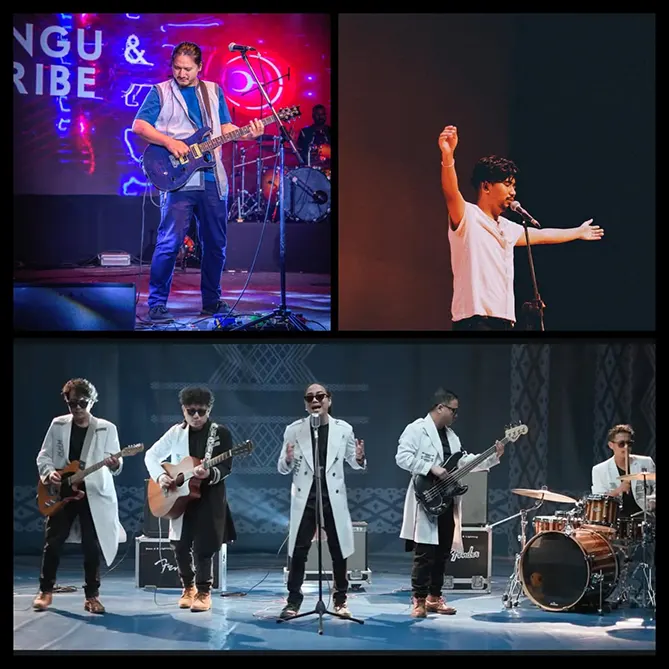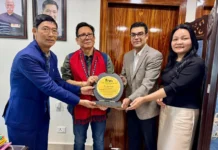TribalBookworms
[ Dr Bompi Riba ]
Journeys can be interesting when we have so much to discuss in a little time with good companions. But if you have no one to talk to while driving alone, the best companion for you is often music. Even for someone like me, who isn’t particularly musical, sitting behind the wheel automatically ignites an inexplicable craving for it. At times, in that moment of silence when you are all by yourself on the road, you momentarily give into the beats of the instrumental sounds that take your soul deep into a cathartic journey to release an overarching emotion that hangs onto each word streaming from the stereo. You either sing aloud or sing along or maybe simply tap your fingers on the wheel as you stare blankly on the road with a cool mind. Of late, I realised that for the past two or three years, most of my long drives felt incomplete without a few favourite songs, and one of them has been ‘Jajinja’ of Chorun Mugli. I had first heard Chorun on repeated mode in the year 2018 while travelling from Agra to Delhi. As our car sailed on the Yamuna Expressway in the sweltering summer heat, the melodious ‘kala kala’ came as a breath of fresh air from the dawn-lit mountains. Though I had quickly moved on from that musical memory, his ‘Jajinja’ came as a bang in 2021 and ever since it has been one of my favourites. Watching the music video, one cannot help but appreciate the seamless harmony of its elements – the cinematography, the mood, the festive spirit, the music, the singer with his guitar, the lyrics, the touching interplay of the generations of the elders and the youths, including the bond between the father and the son. It is an experience that stays with you. Certain songs have the power to evoke pride in your heritage and this is definitely one of them.
Another music video that left a similar effect on me was David Angu & the Tribe’s ‘Ho Delo’, which was released in 2019. In fact, it will not be wrong to call it revolutionary for being the first popular ‘folk-rock’song from Arunachal Pradesh. It had caused a ripple to initiate a wave of fusion and experimentation among musicians that had led to the rise of modern folk music in the state, specifically among the Tanitribes. This song reminisces about the age-old practice of exhorting the men among the Galos for major community works and events, such as going to the field or forest for hunting, fishing, etc. In this version of ‘Ho Delo’, the youths are exhorted to follow the wise words and traditions set by their forefathers to bring light to their area. The light in question is metaphorical and it refers to both traditional and modern education which are required for the holistic development of the society. The uniqueness about this particular music video is the presence of the band of boys in modern attire and a tango (traditional sleeveless jacket) jamming with electric guitars and a drum set against the backdrop of a group of men in traditional bolup (hat), tadok (traditional necklace), tango, habv (loin cloth), rache (cane bag) etc, and singing the rhythmic ‘ho delo’ while performing their daily activities jovially. But what stands out is the extended vocals of the lead singer in high notes in between choruses that gives the feel of rock music. Also, I must say that the music of this song is exceptionally good.
Equally outstanding is Dobom Doji’s reggae rendition of Moge Doji’s classic hit ‘Melo Jajine’. The concept of this music video is innovative and refreshing. It can actually be taken as a template for thinking outside the box while remaining inside the box. Interestingly, the box-like setting of the video symbolically represents the richness of the folklore, where each door opens to another, embodying the idea of how deep your roots are. The song narrates the story of our forefathers who had migrated southwards to reach the present Monigong by travelling along the Siyom river and crossing places like Tade Deegv and Gollo Yorbv. It refers specifically to the story of ato Topo and ato Karbo. According to Professor Tomo Riba, vice-chancellor of the Arunachal Pradesh State University, both Topo and Karbo had settled in the southern end of Monigong, which was called Golo Yorbv. As the place was surrounded by high ridge mountains and a deep gorge on the southern side, they could not move further from there. Gradually, their population increased and the space became constraining for them. So they resolved to follow the omen that would decide their fate of either staying back or migrating again. Thereafter, they performed an ordeal of planting plants like bamboo and gourds to see if the plants would bend northward or southward. Since Topo’s plants had bent southward, he and his descendants had to leave Golo Yorbv. The song narrates this particular incident from the folk memory of the Galos.
‘Melo Jajine’ also evokes the profundity of our forefathers’ wisdom that have been passed onto us in the form of traditions, culture and folklore and the need to continue them is urged. While this song is played in almost all social gatherings today, it shows how music can traverse through language barriers and people can actually connect with it emotionally and enjoy it. In addition to this song, his execution of another popular Galo folk song, viz, ‘Jimi Ane’ is worth mentioning. Morge Ete in his The Folklore of Galo: An Overview addresses Jimi Ane as “the ultimate mother of all.” In order to expound the origin of Abo Tani (Father Tani, from whom the genealogy of the Galos are traced), he explains that in the beginning Jimi Ane was an empty and gaseous universe. He also elucidates that since it was extremely hot, it exploded and resulted with the birth of Donyi (Sun), Polo (Moon), Takar (Stars), Hisi/Sichi (Earth) and eventually the birth of Tani (human being). The song ‘Jimi Ane’ was originally sung by Jomnya Siram and it refers to the Galo cosmology and recounts the genealogy of the Galos from the supreme mother. Dobom Doji gives a new flavour to this old folksong by fusing modern music into it. What stands out in his performance is his powerful vocal that resonates the captivating tone of the shamans while chanting or singing.
One thing about folk music is that much research and documentation are concentrated on preserving the traditional ones in their purest form without inflection from other forms and genres of music. It is obvious that for any community, one of the major concerns is the disappearance of their folklore, within which itself there are varieties, including folk music that cater to the taste and interest of different audiences. What David Angu, Chorun Mugli and Dobom Doji are creating is a new sub-genre of experimental folkmusic which is distinct for their fusion. One may not approve their kind of music on the pretext of not being conventional but one cannot deny that ‘folk music’ is a part of their composition. Instead of being rigid, can we see change as something that is normative and also creative? Because if we subscribe to restricting folk music to only traditional ones and rural environment, then the possibility of relegating it to the past remains strong which may further curtail the scope for their evolution and diverse outcome in the present times. Just as the traditional folk music were cultural expressions of a certain period, the abovementioned fusion artists have also demonstrated their vision for folk music by preserving, disseminating and popularising them in the contemporary times. Through fusion they are also broadening the social basis of music and showcasing how the contemporary modern folk music embraces inclusivity and fosters diversity. It is to be noted that music can be a medium through which the expressive behaviour of the audience can be understood. Therefore, if we remove folk music from its cultural setting, which is rural, to a more modern and urban setting, and if we do not take a parochial stand bydelimiting the evolution of folk music, then its functional role in the urban context can be examined.
It is a well-known fact that folk music fosters its creativity from oral traditions and its authenticity is marked by the use of traditional musical items. If fusion music is seen through this lens, then the real essence of folk music is diluted by the unauthentic elements used in it. But these unauthentic elements are responsible for making the traditional music cross over to the boundary of popular music. For illustration, one can refer to the cultural markers like ‘Oh delo’, ‘Jajin ja’, ‘kolosikoliya’, ‘yoibabua hoi’,etc, becoming mnemonic markers among the audience and eventually becoming part of the popular culture. Memory markers are actually very important for the continuity of oral tradition as they serve as the foundational units of transmission. In traditional setup, folk music was faithfully reproduced as learnt from the elders without much personal expression of individual performers. But today’s young artists are using folk music as a medium of expressing themselves and their identities. They are investing their time to acquire specialised skills and folk memory of their ancestors. They do not deviate too far from the traditional model as they value the expectations of the community they represent. But they also do not fear to experiment with the music to make it more contemporary. So far David Angu & the Tribe has done a phenomenal job by leading the race withan impressive line of modern folk songs rooted in Galo (‘Ho delo’, ‘ommem’, ‘daliyedali’), Apatani (‘paku no’), Nyishi (‘kolosikoliya’) and Tagin (‘jaiye ja’) respectively. Dobom Doji’s ‘Jimi Ane’, ‘AsiNoru eh’, ‘Melo Jajine’ and ‘Mengo rettem’; and Chorun Mugli’s ‘Jajin ja’ and ‘Mangdwr’ (in collaboration with Takar Nabam) are also notable because together they are all creating a unique genre of popular music rooted in traditions, history, myth and the contemporary times of their people.
Their songs are one of the best representations of Arunachal in the global platform. For illustration, David Angu’s ‘Ommem’ (daughter) is a song that celebrates women education and empowerment. This song is modelled on a Galo folksong which was sung for Ami Henam, which according to Morge Ete, was a folkdance meant for the purpose of entertainment for women and doesn’t have any origin in legends. It was performed after dusk by women for recreation after the days’ labour. A few girls would go around the village and the leader would sing, “ajenaiito lake, ajenbaaboaiito lake” and the rest of the girls would sing rhythmically, “yoobaboahoye” as they held each other’s hands and danced with a back-and-forth movement. That song was an exhortation for the friends to come out from their houses to join them in the dance. One can notice how strikingly different is the context of both the situations in the traditional and the contemporary ‘yoobaboahoye’/‘Ommem’ song. And yet the thread that connects both the songs is the empathy for the girls in those situations. Interesting, isn’t it? (Dr Bompi Riba is Assistant Professor, English Department, Rajiv Gandhi University. She is also a member of the APLS and Din Din Club.)





